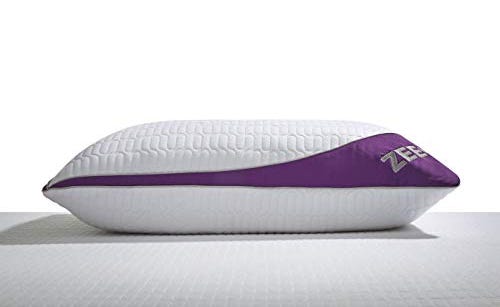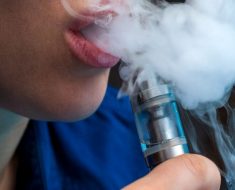Despite the explosion of sleep tech innovation in recent years, relatively few companies have dared to tackle one of the biggest enemies of a good night’s sleep: snoring—the jarring sound produced by vibrations of the upper airway. Some 90 million Americans snore (men more than women), 37 million of them on a regular basis. A healthy subset of those people snore so loudly that they often disturb the sleep of anyone sharing a bed or room with them, all too often to the detriment of relationships. At times, snorers can even wake those in adjacent rooms, if not themselves. Yet, as late as last year, the most innovative anti-snoring solutions all too often involved jamming something up a snorer’s nostrils.
In January, however, attendees at the Consumer Electronics Show saw three smart, high-tech anti-snoring devices on display. First there was Hupnos, a sleeping mask with a silicone nose piece. Hupnos can determine the position a snorer is sleeping in and pair to a bedside phone app that listens for snoring. Once detected, the device gently vibrates to move a snorer from their back, a position that flops tissue back into our throats—often increasing airway vibrations—and onto their side, ideally without waking them. If that fails, it then activates the nose piece, which delivers expiratory positive airway pressure (EPAP)—allowing a wearer to breathe in through the nose, but making it hard to breathe out in the same way. This creates resistance meant to expand lung volume and reduce airway vibrations. It also tracks snorers’ sleep and snoring patterns so that they can better track which lifestyle activities, like drinking or exercise, seem to help or hurt their snoring.
The Philips SmartSleep Snoring Relief Band, on the other hand, straps around a user’s torso, likewise to monitor their sleeping position and unobtrusively nudge them onto their sides if they start snoring. And the Smart Nora, an inflatable insert that goes under a snorer’s old pillow, listens via a paired bedside monitor for snoring and, when detected, unobtrusively lifts their head to reduce snoring without forcing the user into a new position. Like Hupnos, it too offers users tracking features to monitor possible lifestyle snore factors. (It’s worth noting that the Smart Nora is not actually new; it’s been around for a few years. But CES gave it a visibility boost.)
These are far from the only smart anti-snoring devices on the market. In 2017, the Sleep Number 360 smart bed made its debut at the CES, for example, touting its ability to detect snoring and elevate a user as needed for relief. And in 2018, the ZEEQ smart pillow made a few waves, promising to listen for snoring and gently roll a snorer into a new position with internal motors. A couple of other devices also promise to cancel out the sound of snoring. But anti-snoring features have usually been side-notes for bigger sleep tech projects, and snore sound-canceling tech has not gained widespread attention. This latest trio of devices, arguably, has put dedicated snoring solutions on the smart tech map. And while they are not perfect solutions—far from it, actually—they may herald a new and hopeful era for many of the world’s snorers. Or rather, for snorers’ long-suffering partners, roommates, and so on.

Before jumping into what makes this latest wave of smart anti-snoring tech so powerful and promising, however, it’s worth understanding all the low-tech ways humans try to tackle this issue. Humans have been trying to stifle snores for literally thousands of years; ancient Egyptian medical texts list herbal remedies not dissimilar from some still on sale today. For at least the last few hundred years, we have focused in on developing straps, pillows, and prods that make it difficult for snorers to sleep on their backs; nose plugs or nasal strips to widen our nasal airways, or in the case of plugs provide EPAP; and chin straps or mouth inserts to change the position of our jaws, or even move our tongues forward.
The biggest innovation in the field was probably the invention of the Continuous Positive Airway Pressure (CPAP) machine and mask, which pushes warm, moist air down a snorer’s throat to keep the airway wide. This device is widely successful in reducing snoring, but is not convenient to use—hence why anti-snoring innovators have, until relatively recently, focused on making it smaller and more comfortable.
While some of the non-CPAP solutions on the market are not entirely safe, like straps that cover the entire mouth (a patently dumb idea), many of them have their anti-snoring merits. As Andrew Varga, a sleep medicine specialist at New York’s Mount Sinai Hospital, points out, we do know that side sleeping can slop some of our tissue out of the way of our airways. Head elevation can reduce “the collapsibility of the airways,” and there is merit to the theory of EPAP. But many of these solutions are obtrusive and uncomfortable. And none of them can tackle every type of snoring, which stems from any number of causes—from alcohol and sedative usage to physical conditions like a deviated septum, to the sheer body-wide sag of aging.
“Plenty of people,” Varga points out, “still snore on their sides,” so shifting their position wouldn’t help them. Nor, he adds, would products that widen the nasal airways help a mouth or throat snorer. Even people who benefit from head elevation, he notes, may need varying degrees of it depending on the nature of their snoring. “We’re talking up to 45 degrees of head elevation,” Varga explains. It can be difficult for a snorer to figure out, without a willing partner and some experimentation or a focused sleep study, exactly what kind of snorer they are and what specific interventions help.
The new devices on display at CES ultimately all work on some of these old-tech ideas—that keeping users off their backs, or changing the angle of the neck, will reduce snoring, explains David M. Rapoport, another Mount Sinai sleep specialist. “So their core anti-snoring tactics are old,” he says. Even their makers freely acknowledge the historic precedent for their devices’ core mechanics.
What is new about them, Rapoport argues, is that they are not fixed devices that offer the same nudge or adjustment to every sleeper when they lay down to sleep. They all wait for the snorer to start snoring before they kick in. Mark Michels, head of healthy sleep solutions at Philips, adds that their band’s tech does not just respond when snoring starts and let up when it abates; it learns a snorer’s sleeping patters to adjust its vibration intensity and pattern to meet a sleeper’s comfort and reactivity needs—even if and as they evolve.
Hupnos is uniquely intriguing, Varga adds, because it offers a unique two-step therapy, moving to selectively operational EPAP if gentle repositioning doesn’t solve snores. These devices’ tracking functions are attractive additions to the anti-snoring field too, adds Nitun Verma, a sleep medicine specialist and spokesperson for the American Academy of Sleep Medicine, as they make it much easier to track how your lifestyle changes affect your snoring.
That said, these new devices are in many ways as limited as the old tech they evolved from. Smart Nora, for instance, has boasted that it works for all types of snorers. But it wouldn’t work for those who need extreme elevation to alleviate their snoring—if elevation works for them at all. And even if it does work for many types of snorers, it won’t work for sleepers who move off of their pillows most nights, or who do not use pillows. Michels argues that the Philips band has reduced snoring for 88 percent of the snorers who have used it. But it will not work for those who snore on their sides.
Neither will the first step of Hupnos’s therapy. And its EPAP will not have an effect, Varga points out, on nighttime mouth breathers. Even for nose breathers, he says, “the minute you open your mouth, it drastically reduces the effect because you really need to be breathing almost exclusively through your nose to get the benefits of EPAP.” These therapy resistant types of snoring aren’t fringe cases. Ultimately, Rapaport argues, these devices will fail to help a significant number of potential users. With all these limitations and caveats, it is fair to wonder if these devices are worth common smart tech price points. Philips’s band is not yet on the market, but Hupnos retails for about $180 and the Smart Nora goes for up to $300—sums that seem vast compared to $10 for 26 Breathe Right strips.
“For people that live with a snorer and are just dying every night,” though, argues Varga, that price might seem fair—if the device works. Because it is so hard to predict if a given device will work, doctors usually suggest that snorers try other free or cheap solutions first: If lifestyle changes or simple fixes like a nasal strip, or even just decongestants, work for you without disturbing your sleep, then there’s really no reason to go in for something “smart,” flashy, and expensive. And if a bed partner or roommate can help a snorer figure out which interventions work and which don’t, it can help them figure out if these devices would likely work for them and are worth the cash.
Doctors also caution that these devices are not for snorers whose nighttime noises are linked to sleep apnea, a condition in which individuals stop breathing at points while they sleep. Apnea has been associated with elevated risks for heart disease and seemingly exacerbates health conditions. Anyone who suspects they might have apnea ought to seek medical help rather than anti-snoring tech, all of the sleep experts I’ve spoken to agree.
Doctors may prescribe anything from lifestyle changes to CPAP to surgery in order to treat apnea and related snoring. But none of them would recommend the sort of devices on display at the CES. In fact, “a scary scenario would be a loud apnea patient having their snoring silenced,” says Verma, which would turn their apnea into a quiet condition and leave the patient with “all the health side effects.” For snorers who know that they do not have apnea, however, and believe their variety of snoring could benefit from the therapies these devices offer, they are a real boon—comfortable and responsive.
That may not seem like much, but to a subset of snorers and those in their lives, it might mean the world. More importantly, even if these early pieces of smart anti-snoring tech are limited in their utility, they offer a path forward for future iterations—towards responsiveness, learning, and adaptable therapies. This flexibility will work far better to address the diverse types of snoring and their causes, and work better for the varied sorts of sleepers out there than the old, fixed anti-snoring tech that has for centuries defined our attempts to sleep peacefully—and quietly.
Source: Read Full Article





